Unit 3. World War I
1/18
Earn XP
Name | Mastery | Learn | Test | Matching | Spaced |
|---|
No study sessions yet.
19 Terms

The diagram below provides details about the origins of World War I.
Which phrase completes the diagram?
A. Alliance System
B. Social Revolution
C. Drought and Famine
D. Worldwide Economic Depression
A. Alliance System
Which group of adult males, ages 21 to 30, was NOT required to perform active duty in the U.S. military during World War I?
A. African Americans
B. Conscientious Objectors
C. People who opposed the war
D. Native Americans with U.S. citizenship
B. Conscientious Objectors

The table below gives details about United States trade.
Which event was responsible for the changes in trade shown on the table?
A. The United States boycotted Germany after it invaded neutral Belgium
B. Submarine warfare made it difficult to ship goods safely to the Central Powers
C. The convoy system helped protect American ships carrying supplies to Germany
D. The British naval blockade of the North Sea cut off American trade to the Central Powers.
D. The British naval blockade of the North Sea cut off American trade to the Central Powers

The cartoon on the left was published on February 1, 1917. The “notice” from Germany to Uncle Sam states the following:
Ruthless warfare at sea. Ships enter blockade zone at their risk. Pledges as to warnings cancelled. GERMANY
What was the effect of the message shown in this cartoon?
A. The United States declared war after the USS Maine was blown up in Havana Harbor
B. The United States declared war after Germany sank American ships in the blockaded zone
C. The Zimmerman telegram offered Florida and Georgia to Mexico in exchange for an alliance
D. Germany announced it would not attack passenger ships or merchant ships without warning
B. The United States declared war after Germany sank American ships in the blockaded zone
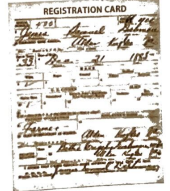
The card on the left was used by a 33-year-old man to register with the Selective Service in 1917.
Why did Congress feel this registration was necessary?
A. The United States needed to raise troops to fight overseas
B. The United States needed to increase its agricultural production
C. The United States needed laborers to replace men in the armed services
D. The United States needed to produce war goods, such as ships and uniforms
A. The United States needed to raise troops to fight overseas

The message below was sent in secret code by Foreign Minister of Germany to the German Ambassador to Mexico in January 1917. It was discovered and deciphered by the British government.
What was the impact of the publication of this letter?
A. Mexico allied with Germany in World War I
B. American public opinion was outraged against Germany
C. The United States Senate immediately declared war on Germany
D. The United States paid Mexico compensation for its lost territories
B. American public opinion was outraged against Germany
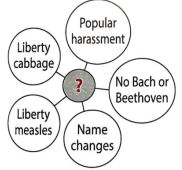
The graphic organizer on the left gives details about American society, April 1917 - November 1918.
What would be the appropriate title for the graphic organizer?
A. The Impact of World War I on Women
B. The Impact of World War I on Hispanics
C. The Impact of World War I on German Americans
D. The Impact of World War I on the Federal Government
C. The Impact of World War I on German Americans
What caused African American demographic patterns in the United States to shift during World War I?
A. The closing of factories in the South
B. effects of the Civil Rights Movement
C. greater job opportunities in Northern cities
D. the availability of cheap farmland in the North
C. greater job opportunities in Northern cities
Which sentence describes the experiences of African-American soldiers during World War I?
A. They were unable to engage in combat because of racial prejudice
B. They successfully persuaded the government to desegregate the army
C. They were segregated but many engaged in combat under French command
D. They were treated as equals with ample opportunity for advancement through the ranks
C. They were segregated but many engaged in combat under French command
Which federal agency created posters, printed pamphlets and made news-reels to support America’s war effort in 1917-1918?
A. Committee of Public Information
B. War Industries Board
C. Food Administration
D. War Labor Board
A. Committee of Public Information
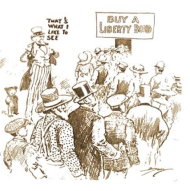
The cartoon on the left was published on May 17, 1917.
What was the purpose of the bonds being sold in the cartoon?
A. to avoid an economic depression
B. to keep the United States out of war
C. To help finance the American war effort
D. to make emergency loans to Britain and France
C. To help finance the American war effort
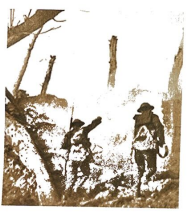
The photograph on the left shows American infantry in France in 1918.
What would be the best caption for this photograph?
A. The introduction of tanks end trench warfare
B. Battlefield devastation from aircraft bombardment
C. Crossing “No Man’s Land” to reach an enemy trench
D. Troops get exercise by running along an Allied trench
C. Crossing “No Man’s Land” to reach an enemy trench
Why did the United States Senate fail to ratify the Treaty of Versailles in 1919?
A. Many Senators opposed the severe sanctions that the treaty placed on Germany
B. Many Senators feared the League of Nations would involve the United States in foreign wars
C. Many Senators felt the League of Nations would interfere with American plans in the Philippines
D. Many Senators predicted the membership in the new League of Nations would be too expensive
B. Many Senators feared the League of Nations would involve the United States in foreign wars
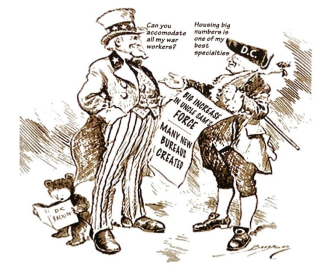
The cartoon below was published in May 1917.
What was NOT one of the “new bureaus” referred to in this cartoon?
A. War Industries Board
B. Railroad Administration
C. American Federation of Labor
D. Committee of Public Information
C. American Federation of Labor

The excerpt below is from the Supreme Court Justice Oliver Wendell Holmes’ opinion in Schneck v. United States (1919).
Based on the excerpt, with which statement would Oliver Wendell Holmes have agreed?
A. Freedom of speech is not absolute
B. Prayer in public schools is unconstitutional
C. Immigration from other countries cannot be permitted during wartime
D. Criticism of polices of allied countries must be temporarily prohibited during wartime
A. Freedom of speech is not absolute

The excerpt below is from the Covenant of the League of Nations, a part of the Treaty of Versailles.
Why did many U.S. Senators object to this article?
A. They had plans to seize new overseas territories for the United States
B. They were afraid that the League would be controlled by hostile powers
C. They feared Americans would be required to to act against aggression in Europe
D. They thought it demanded that Americans grant Philipines independence
C. They feared Americans would be required to act against aggression in Europe
Which sentence best describes the impact of World War I on Florida?
A. Governor Sidney J. Catts lifted the state’s prohibition of alcoholic drinks during wartime.
B. Large numbers of Cubans moved to Florida to find work in America’s wartime industries
C. Military training centers were located in Florida, the state’s farmers sold more crops, and a thousand Floridians gave their lives
D. After fighting for democracy abroad, most Floridians became more willing to grant equal rights to African Americans at home.
C. Military training centers were located in Florida, the state’s farmers sold more crops, and a thousand Floridians gave their lives
Which best describes how American women reacted to American participation in World War I?
A. Some protested but most supported the war effort and many filled men’s jobs
B. Because of a shortage of enlisted men, many women served in combat for the first time
C. Women’s continuing protests for women’s suffrage dangerously impeded the war effort
D. Large numbers of women were forced to move from their homes to meet wartime needs
A. Some protested but most supported the war effort and many filled men’s jobs
Which was NOT one of President Woodrow Wilson’s Fourteen Points?
A. creation of an independent Poland
B. lenient treatment of the Central Powers
C. creation of a peace-keeping association of nations
D. autonomous development for the people of Austria-Hungary and the Ottoman Empire
B. lenient treatment of the Central Powers